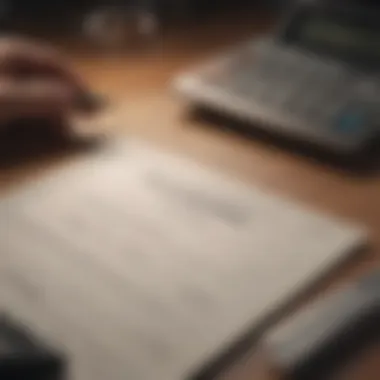Effective Strategies for Paying Off Credit Card Debt


Intro
Credit card debt is a burden that many people carry. For young professionals, students, and small business owners, the allure of credit is often overshadowed by the stress of managing payments. This section aims to clarify fundamental concepts that underlie effective debt repayment strategies.
Understanding financial terms and concepts can significantly influence how you approach debt. A few key terms to grasp include interest rates, minimum payments, and credit utilization. When addressing these terms, developing a solid foundation in financial literacy becomes crucial.
- Interest Rates: This refers to the cost of borrowing money on credit cards. The higher the rate, the more you pay back over time.
- Minimum Payments: This is the least amount required to keep your account in good standing. However, only making the minimum can lead to prolonged debt.
- Credit Utilization: This metric involves the ratio of your credit card balances to credit limits. A lower utilization rate is beneficial for maintaining a healthy credit score.
Understanding Financial Concepts
Definition of Key Terms
In the realm of finance, a firm grasp of essential concepts can empower individuals. Debt itself is money borrowed that needs to be repaid, usually with interest. For credit cards, interest can accumulate quickly if balances are not paid in full.
Another important idea is amortization, which refers to the process of gradually paying off debt through consistent payments. Recognizing how payments are applied between principal and interest is vital.
Importance of Financial Literacy
Financial literacy equips individuals with knowledge, enabling informed decisions. Understanding your financial health allows you to create a strategic plan for paying off debt.
"An investment in knowledge pays the best interest."
- Benjamin Franklin
With improved literacy, one can better navigate the pitfalls of credit card debt. Personalized strategies can then be created based on individual circumstances and goals.
Practical Tips and Strategies
Budgeting Techniques
Creating a solid budget is foundational in managing credit card debt. Start by assessing monthly income and expending. Categories should include:
- Fixed expenses (rent, utilities)
- Variable expenses (food, entertainment)
- Debt payments
Using tools like spreadsheets or budgeting apps can provide clarity. Allocating specific amounts toward debt each month can accelerate payoff timelines.
Investment Approaches
While paying off debt, some may consider investing. However, this should be balanced carefully. If the interest on debt exceeds potential investment gains, it could be wiser to focus on reducing debt first.
In summary, understanding core financial concepts and employing practical strategies undoubtedly enhances one's ability to manage and pay off credit card debt. As you develop these skills, taking control of your financial situation begins to feel more achievable.
Understanding Credit Card Debt
Understanding credit card debt is a crucial first step for anyone who is looking to manage and eventually eliminate their financial burdens. Credit card debt can easily spiral out of control due to various factors, including lifestyle choices, economic circumstances, and the lack of clear financial strategies. This section aims to elucidate the different dimensions of credit card debt, including its definition, the typical reasons people accrue this type of debt, and the detrimental effects of high-interest rates. By grasping these concepts, individuals can equip themselves with the necessary tools to address their debt more effectively.
Defining Credit Card Debt
Credit card debt refers to the outstanding balance that a cardholder owes to their credit card issuer. When purchases are made with a credit card, the user is essentially borrowing funds from the bank or credit institution, which must be paid back later. If the balance is not paid in full by the due date, interest begins to accrue on the unpaid amounts. It is important to note that credit card debt can vary significantly depending on one's spending habits, income, and repayment abilities.
Common Causes of Accumulating Debt
There are multiple factors that contribute to the accumulation of credit card debt. Some common causes include:
- Unexpected Expenses: Emergencies like medical bills or car repairs can result in unplanned spending.
- Lifestyle Inflation: As income increases, individuals often upgrade their lifestyles, leading to higher expenses that may not align with their income growth.
- Lack of Budgeting: Without a clear financial plan, spending can exceed what one can afford, leading to accumulating debt.
- Peer Pressure: Social influences can result in overspending on non-essentials to maintain a certain lifestyle.
These factors underscore the importance of self-awareness and financial discipline in managing finances.
The Impact of High-Interest Rates
High-interest rates can significantly worsen the burden of credit card debt. Credit cards often come with various annual percentage rates (APRs), which can range from moderate to exorbitantly high. When payments are continually deferred, the accumulated interest compounds, ultimately increasing the total amount owed. The following points illustrate the impact of high-interest rates:


- Longer Repayment Times: Higher interest rates extend the repayment period, making it difficult to pay off the debt in a reasonable timeframe.
- Increased Financial Stress: The mental strain of chronic debt can affect overall well-being and lead to poor financial decisions in the long run.
- Potential for Default: In severe cases, failure to manage debt can result in default, leading to severe credit score damage and difficulty in obtaining future credit.
Understanding these facets of credit card debt is essential for crafting a strategy to regain financial control and work toward a debt-free future. It's crucial to identify the root causes of debt accumulation and the implications of high-interest obligations to create effective solutions.
Analyzing Your Financial Situation
Understanding your financial situation is a vital step in the journey towards paying off credit card debt. It allows you to identify the core issues affecting your financial health. By analyzing your finances, it becomes possible to adopt a targeted approach to managing and ultimately eliminating debt.
Assessing your financial situation helps you see the full picture. It gives you insight into how much debt you have, your income level, and your spending habits. When armed with this knowledge, you can create a concrete plan addressing the specific challenges you face. Recognizing your financial standing opens opportunities for informed decisions to improve your circumstances.
Calculating Total Debt
The first step in analyzing your financial situation is calculating your total debt. This is more than just looking at one or two credit cards; you need a comprehensive view of all your obligations. Include credit cards, personal loans, student loans, and any other debts in this calculation.
To accurately determine this:
- Gather all your statements from various lenders.
- Note the outstanding balances on each account.
- Include interest rates and the minimum payment amounts.
It's crucial to create an organized list, perhaps in a spreadsheet. This makes it easier to maintain clarity as you move forward with any debt repayment strategy. Not only will you see the total amount you owe, but you’ll also understand which debts are costing you the most in terms of interest.
Assessing Monthly Income and Expenses
Next, assess your monthly income and expenses. Understanding how much money comes in each month versus how much goes out is essential for effective financial management. This assessment allows you to identify potential savings or areas where you can cut back.
Start by calculating your net monthly income, which is your salary after taxes and other deductions. Then, list all your monthly expenses including:
- Rent or mortgage payments
- Utilities
- Groceries
- Transportation
- Entertainment
- Minimum debt payments
Once you have these figures, subtract your total expenses from your income. This will give you a clearer picture of your financial health. If your expenses exceed your income, you face a more significant challenge in managing your debts. Understanding this gap is essential.
Identifying Disposable Income
The last part of analyzing your financial situation is identifying your disposable income. Disposable income is what remains after all essential expenses have been paid. This amount is crucial because it determines how much you can allocate toward debt payments.
To calculate this:
- Use the total monthly income you have already assessed.
- Subtract total monthly essential expenses (like rent, groceries, and other obligations).
The remaining figure represents your disposable income. This amount can be used for extra payments on credit cards or savings. If you find that your disposable income is minimal, consider if you need to tighten your budget further or explore additional sources of income.
Estimating your financial situation, calculating total debt, assessing income and expenses, and identifying disposable income are critical steps in managing credit card debt. By understanding these components, readers can develop more effective strategies to regain control over their finances.
Creating a Strategic Payment Plan
Creating a strategic payment plan is crucial when addressing credit card debt. It provides structure and focus to your payment efforts, making it easier to reduce overall debt. A well-thought-out plan considers your specific financial situation and the available strategies to enhance recovery. This strategic approach can lead to greater motivation and financial discipline, both necessary for achieving debt freedom.
Choosing Payment Strategies
Choosing the right payment strategy can significantly influence the success of your debt repayment efforts. The two most prominent methods are the Debt Snowball Method and the Debt Avalanche Method.
Debt Snowball Method
The Debt Snowball Method encourages individuals to focus on paying off the smallest debts first. By doing so, it creates quick wins that can boost motivation. This strategy is beneficial because it provides a sense of accomplishment and progress. The immediate payoff of smaller debts can lead to a psychological boost, making it easier to tackle larger debts as they receive more attention over time.
One unique feature of the Debt Snowball Method is its emphasis on emotional impact over mathematical precision. While it might not be the most economical choice—since smaller debts may carry lower interest rates—it builds momentum. However, one disadvantage is that it could lead to paying more interest in the long run than other methods.
Debt Avalanche Method
In contrast, the Debt Avalanche Method focuses on paying off debts with the highest interest rates first. This strategy minimizes overall interest paid and can lead to faster debt elimination within a shorter time. A key characteristic of the Debt Avalanche Method is its logical approach; it directly addresses cost. As a result, it is a popular choice for those who prioritize financial efficiency.
The unique feature of this method lies in its systematic approach to debt repayment. It is often considered more financially sound, but some find it less motivating compared to the Debt Snowball Method. Big debts may take longer to pay off, which can affect long-term morale.
Setting Realistic Goals
Setting realistic goals is essential for anyone trying to pay off credit card debt. Clear, achievable goals help maintain focus and ensure progress. Break down larger debts into smaller, manageable milestones so it does not seem overwhelming. Consider not just paying off debt, but creating a timeline with specific targets for each monthly payment. This creates accountability and allows for adjusting your plan as needed.


Adapting to Changes in Financial Circumstances
Life is unpredictable, and your financial situation may change. Being flexible and able to adapt to new circumstances is critical. If you experience a change in income, such as a raise or job loss, revisit your payment plan. Adjustments might mean paying less for certain months or prioritizing funds differently. Regularly review your financial situation to keep track of expenses and debts, allowing you to stay on course even when challenges arise.
"A well-defined payment plan can empower individuals, making debt less daunting and opening pathways to financial health."
Using these strategies will help create a custom plan that effectively targets your credit card debt. With careful implementation, achieving financial goals becomes attainable.
Implementing a Budget
Implementing a personal budget is crucial for anyone coping with credit card debt. A well-designed budget serves as a roadmap. It helps one understand where money is going and where it can be saved. Many individuals can find themselves in debt due to unmonitored expenses. By establishing a budget, you can identify discretionary spending and prioritize debt payments effectively.
Establishing a Personal Budget
To begin, gather all financial documents. These usually include bank statements, pay stubs, and credit card bills. Next, list all sources of income, including salaries, side jobs, and any passive income. This gives you a clear picture of your total earnings.
Then, move to expenses. Categorize them into fixed and variable. Fixed expenses are predictable payments. These cover rent or mortgage, insurance premiums, and monthly subscriptions. Variable expenses include groceries, entertainment, and dining out. Tracking these categories allows you to see where your money flows and helps in finding areas to cut back.
Incorporating Debt Payments into the Budget
Once the budget is clear, it's time to incorporate credit card debt payments. Start by allocating a specific portion of your disposable income toward these payments. Consider the following when adjusting your budget:
- Minimum payments: Always ensure you cover at least the minimum due to avoid penalties.
- Extra payments: If possible, allocate additional funds to higher-interest debts. This can significantly reduce the total interest paid over time.
- Regular reviews: Financial situations can change. Make it a habit to review your budget monthly and make adjustments as needed. This keeps your plan realistic and achievable.
Adjusting Spending Habits
Adjusting spending habits is essential in the overall debt repayment strategy. Reflect on your spending patterns. Identify unnecessary expenses that can be reduced or eliminated completely. Here are some strategies:
- Needs vs. wants: Differentiate between essential items and luxury purchases.
- Impulse control: Implement a 24-hour rule for purchases to avoid impulse buys.
- Use cash: Limit credit card usage. Instead, use cash for daily purchases. This helps to physically see money being spent.
Research shows that those who implement budgeting strategies can effectively reduce debt, keeping financial stability within reach.
By continually monitoring and adjusting your budget, you can create an environment conducive to paying down debt. This structured approach leads to greater financial awareness and ultimately financial freedom.
Exploring Debt Relief Options
Exploring debt relief options is a crucial aspect of managing credit card debt. Many individuals find themselves overwhelmed by high interest rates and increasing balances. Therefore, understanding available options can provide significant benefits. These debt relief methods may lower monthly payments, reduce debt loads, and even assist in avoiding bankruptcy. However, it is essential to approach each option thoughtfully. Not all strategies will suit every financial situation.
Negotiating with Creditors
Negotiating with creditors can be an effective tool for reducing debt. The goal is to discuss better repayment terms or settlements. Many creditors are willing to work with consumers to improve payment compliance. Consider the following points:
- Direct Communication: Reach out to creditors directly. It's often recommended to call customer service directly to discuss your situation. During these conversations, it is helpful to be honest about your financial difficulties.
- Present Your Case: Explain why you are struggling and ask for relief options. Sometimes creditors may lower interest rates or offer a temporary payment plan.
- Document Everything: Keep notes of all interactions. Record names, dates, and the outcomes of each conversation. This can be helpful if you need to follow up later.
Through negotiation, borrowers can achieve lower payments and, in some cases, a reduction in total debt. This direct approach often leads to favorable outcomes and sometimes provides creditors with assurance your payments will continue.
Utilizing Debt Management Services
Debt management services can be beneficial for those who find it hard to negotiate effectively on their own. These services assist in creating a structured repayment plan. Here are key aspects of such services:
- Professional Guidance: These organizations offer trained professionals who can provide insights into debt repayment strategies. They help individuals better understand their financial options.
- Consolidation of Payments: Debt management plans often consolidate multiple debts into one monthly payment. This can simplify budgeting and payment tracking.
- Potential Interest Rate Reductions: Some debt management companies negotiate directly with creditors to reduce interest rates.
However, it's crucial to choose reputable firms. Look for accredited organizations to avoid potential scams. Research results and reviews from past clients can also guide the right choice.
Considering Debt Consolidation
Debt consolidation is often an effective method to manage multiple credit card debts. This strategy involves combining various debts into a single loan, usually at a lower interest rate. Here are key points to consider:
- Types of Consolidation: There are personal loans, home equity loans, or balance transfer credit cards. Each option has different implications for interest rates and repayment timelines.
- Lower Monthly Payments: Consolidation can effectively reduce monthly payments, making them more manageable. It's also straightforward to manage only one payment.
- Impact on Credit Score: While consolidation can improve payment history, it is essential to be aware of its effect on your credit score. Avoid applying for multiple loans at many institutions simultaneously.
Ultimately, debt consolidation can simplify one's financial life by grouping debts together. It offers a clearer path to repayment but requires careful analysis of interest rates, terms, and possible fees.


"The right choice of debt relief option can significantly change your financial outlook. Consider all possibilities carefully."
Maintaining Financial Discipline
Maintaining financial discipline is a crucial aspect of successfully paying off credit card debt. It encompasses the deliberate and consistent management of expenses, income, and savings. Financial discipline is not merely about avoiding frivolous spending; it is about adhering to a structured plan designed to achieve long-term financial stability. By embracing this discipline, individuals can effectively navigate through their credit card debt and minimize the chances of falling into further debt.
Staying Informed about Financial Options
Staying informed about financial options is essential for maintaining financial discipline. Knowledge is the first step in making effective decisions. Understanding the terms of credit, interest rates, and various repayment methods empowers individuals to manage their debts proactively. Resources such as financial blogs, educational videos, and forums like Reddit can offer useful insights and updates. It is also prudent to review basc financial products available, as some may offer lower interest rates or advantageous payment plans. Keeping up to date with financial news enables better choices and helps in strategizing on how to pay off debts more efficiently.
Avoiding New Debt Accumulation
Avoiding new debt accumulation is a fundamental element of financial discipline. When struggling to pay off existing credit card balances, taking on additional debt can create an unsustainable cycle. It is vital to limit usage of credit cards during the debt repayment period. One effective approach is to keep credit cards out of easy reach or, for some, even temporarily closing accounts. This approach encourages reliance on cash or debit, fostering a mindset focused on spending within one’s means.
Practical steps include:
- Developing a strict monthly budget.
- Distinguishing between wants and needs before making purchases.
- Implementing a 24-hour rule for larger purchases.
Monitoring Financial Progress
Monitoring financial progress is critical for maintaining financial discipline. It allows individuals to see the effectiveness of their strategies in real time. Regularly checking in on balances, payment schedules, and budgeting can offer motivation and highlight any necessary adjustments.
Keeping a financial journal or using apps to track expenses can simplify this process. Furthermore, setting aside time each month to review the budget and debt status can solidify the habit of vigilance. Celebrate small wins to encourage continued commitment to the financial discipline journey.
"Discipline is the bridge between goals and accomplishment."
In essence, maintaining financial discipline is about foresight, restraint, and continuous learning. It asks individuals to be realistic about their financial capabilities while pushing towards a debt-free future.
Reflecting on Financial Habits
Understanding and reflecting on one's financial habits is crucial in the process of paying off credit card debt. This section encourages individuals to take a step back and closely examine their financial behaviors, which can ultimately lead to more informed decisions about their spending and saving practices. By identifying patterns of past spending, individuals can gain valuable insights into their financial health and how to improve it moving forward.
Evaluating Past Spending Behavior
The first step in reflecting on financial habits is evaluating past spending behavior. This involves reviewing bank statements and credit card bills to track where money is being spent. It can be helpful to categorize expenses into essential and non-essential items. By doing this, individuals might discover that a significant portion of their income goes to lifestyle choices that may not be necessary. This understanding can be valuable. It helps prioritize necessary expenses and reduces discretionary spending which often leads to debt.
Learning from Mistakes
Reflecting on financial habits also includes recognizing mistakes made in the past. This might be overspending during particular months or impulse purchasing. Acknowledging these errors is not about feeling guilty; rather, it’s an opportunity to learn. For instance, it might be beneficial to consider what triggered the spending urge. Was it a stressful week? Or perhaps a peer influence? Understanding these reasons can help in developing strategies to avoid similar situations in the future. Setting limits on spending or establishing a waiting period for purchases can be effective methods to manage impulses.
Setting Future Financial Goals
Once past behavior is understood, the next logical step is to set future financial goals. These goals should be specific, measurable, achievable, relevant, and time-bound (SMART). For individuals struggling with credit card debt, a practical goal may be to reduce total debt by a specific percentage within a certain timeframe. Another example could be saving a particular amount each month. Setting these goals can provide clear direction and motivation. It helps in creating a financial roadmap that not only aims to reduce existing debt but also builds savings for future needs.
Reflecting on financial habits is a vital process that contributes to effective management of credit card debt. By evaluating past behaviors, learning from mistakes, and setting clear goals, individuals equip themselves with the tools necessary to regain control over their financial future.
"Reflecting on one's financial habits paves a clearer path towards sound decision-making and better financial outcomes."
This step of reflection and realization fosters a foundation for smarter spending and a more secure financial lifestyle.
Closure: Path Forward
Recap of Key Strategies
Reflecting on the pathways that lead to the elimination of credit card debt is essential. Here is a summary of the pivotal strategies discussed:
- Understanding Personal Debt: Recognizing the breadth of one’s credit card debt and its implications.
- Tweaking Financial Plans: Reassessing budgets to factor in debt repayments.
- Implementing Effective Payment Methods: Choosing between the debt snowball method and the debt avalanche method for optimized repayments.
- Seeking Professional Guidance: Engaging with debt management services or considering consolidation options.
- Evaluating Progress: Continuously monitoring expenses helps in adjusting strategies as financial situations change.
These strategies are not one-size-fits-all. Each individual must adapt them to their unique financial realities and lifestyles.
Final Thoughts on Financial Empowerment
Financial empowerment arises from informed decisions and sustained discipline. Managing credit card debt effectively lays a strong foundation for future financial health. Engaging with personal finance concepts encourages individuals to take charge. Transparency about one’s financial status reduces anxiety and fosters proactive solutions.
"Understanding your debts gives you the power to change your financial narrative."
Small steps, such as tracking spending habits or developing a budget, contribute to significant improvements over time. When young professionals and small business owners understand their financial situation, they can create paths toward not just debt resolution but broader financial literacy. Ultimately, empowerment is not solely about eliminating debt; it is about building a resilient financial future.







